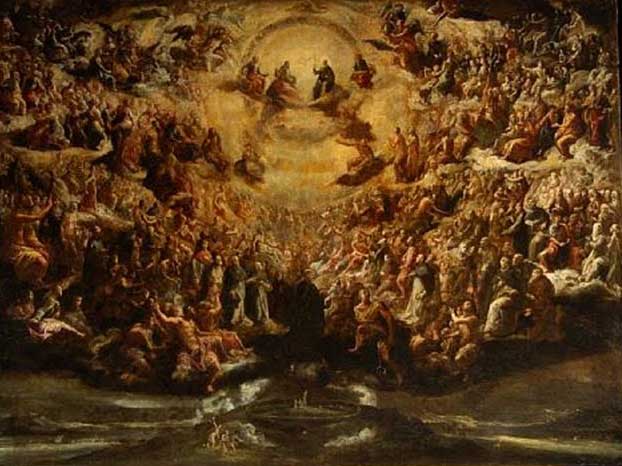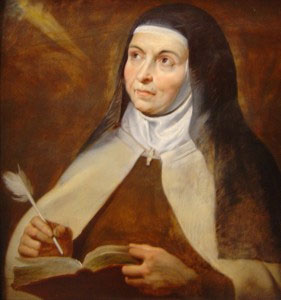[powerpress]
Known as the “Doer”, St. Basil the Great is an extraordinary figure in our Christian heritage.
Our Holy Father, Pope Benedict XVI has said,
Saint Basil the Great, one of the most eminent Fathers of the Eastern Church, showed to all those who wished
to give themselves completely to God the way of monastic life, “where the precept of concretely lived charity becomes the ideal of human coexistence, where the human being seeks God without limitation or impediment†(cf. Orientale Lumen, 9). Saint Basil is for you a model of perfect service of God and the Church. His whole life consisted in the harmonious exercise of the virtue of faith and in acts of practical love in the spirit of the evangelical counsels. Down the centuries the teaching of Saint Basil has borne mature fruits of religious life, especially in the East.
Take a listen to the interview above with Mike Aquilina and learn so much more about this “great” Father of the Church
Tags: faith, mike aquilina, Orientale Lumen, Saint Basil, st. basil the great, st. paul center for biblical theology
This entry was posted on Wednesday, January 2nd, 2013 at 12:05 am
You can follow any responses to this entry through the RSS 2.0 feed.
“Be Saints!  An invitation from Pope Benedict XVI”, edited by Amy Welborn and illustrated by Ann Engelhart is simply wonderful, a  must for every family library.  Marvelous for children and adults alike, this compilation is taken from the talks given by Pope Benedict to children during his 2010 visit to England.  In this conversation with Ann Engelhart, we discuss this work.  We  also discuss the nature of art and beauty, in particular for children, and it’s ability to evangelize.
must for every family library.  Marvelous for children and adults alike, this compilation is taken from the talks given by Pope Benedict to children during his 2010 visit to England.  In this conversation with Ann Engelhart, we discuss this work.  We  also discuss the nature of art and beauty, in particular for children, and it’s ability to evangelize.
[powerpress]
 You can find the book here
You can find the book here
From the description:
In this very colorful book by acclaimed artist Ann Englehart, the Pope’s words come to life as he interacts with the children, showing all children how only God can satisfy the deepest needs of our hearts.
Interspersed are prayers and quotes from various saints including Saint Francis, Saint Ignatius, Mother Teresa, St. Paul, St. Peter and more. They all emphasize that the most important thing we can become in this life is a Saint, a true friend of Jesus.
Tags: amy welborn, Ann Engelhart, children, ignatius press, pope benedict
This entry was posted on Thursday, December 20th, 2012 at 12:39 pm
You can follow any responses to this entry through the RSS 2.0 feed.
VATICAN CITY, 16 FEB 2011 (VIS) – In his general audience today, held in the Paul VI Hall, the Pope focused his attention on St. John of the Cross, “spiritual friend to St. Teresa and, with her, reformer of the Carmelite religious family. Proclaimed a Doctor of the Church by Pius XI in 1926, he is traditionally known as the ‘Doctor mysticus’, the Mystical Doctor”, the Holy Father said.
John was born to a poor family at Fontiveros near the Spanish town of Avila in 1542 and entered the Carmelite order at Medina del Campo. Ordained a priest in 1567, it was on the occasion of his first Mass that he met Teresa, “who explained to him her plan for the reform of the Carmelites”. In his renewal of his religious profession John took the name “of the Cross” and collaborated enthusiastically in the process of reform, something “which brought him great suffering”, and even led to his imprisonment following an unjust accusation. While preparing a journey to Mexico he fell seriously ill and died in December 1591. He was beatified by Clement X in
1675 and canonised by Benedict XIII in 1726.
St. John of the Cross, said Benedict XVI, “is considered one of most important lyric poets of Spanish literature. He wrote four major works: ‘Ascent of Mount Carmel’, ‘Dark Night of the Soul‘, ‘Spiritual Canticle’ and ‘Living Flame of Love‘.
“In his ‘Spiritual Canticle’ St. John outlines the soul’s journey of purification”, the Holy Father added. “The ‘Living Flame of Love’ continues in the same line, describing in greater detail the condition of union with God. … ‘Ascent of Mount Carmel’ outlines the spiritual itinerary from the point of view of a progressive purification of the soul, which is necessary in order to scale the heights of Christian perfection, symbolised by the summit of Mount Carmel”.
The Pope continued his catechesis by explaining how “the ‘Dark Night of the Soul’ describes the ‘passive’ aspect; in other words, God’s contribution to the process of purifying the soul. Human effort alone, in fact, is incapable of reaching the deepest roots of a person’s bad inclinations and habits. It can halt them but not eradicate them completely. To do this, we need a special action by God which radically purifies the spirit and disposes it to the union of love with Him“.
“The rate of increase of faith, hope and charity goes hand in hand with the work of purification and with progressive union with God, until attaining transformation into Him. When this goal is reached, the soul is immersed in Trinitarian life itself. … This is why the Mystical Doctor held that there is no true union of love with God that does not culminate in Trinitarian union”.
The Pope completed his remarks by asking whether the life of St. John of the Cross has anything to say to everyday Christians, or whether it is an example only for the few select souls who can follow the path of purification and mystical ascesis. “The journey with Christ, travelling with Christ … is not an additional weight to the already sufficiently-heavy burden of our lives”, he said. “It is something totally different. … It is a light, a power which helps us carry our everyday burden. … Allowing ourselves to be loved by Christ is the light which helps us to carry the daily burden, and sanctity is not a task we must accomplish on our own, a very difficult task. … Let us ask God to help us become saints, to allow ourselves to be loved by God, which is the vocation and true redemption of us all”.
Published by VIS – Holy See Press Office – Wednesday, February 16, 2011
Tags: ascent of mount carmel, carmelite order, carmelites, dark night of the soul, doctor of the church, family, heart, holy father, hope, love, Mystical Doctor, purification of the soul, spanish literature, spiritual friend, st. john of the cross, union with god
This entry was posted on Friday, December 14th, 2012 at 12:19 am
You can follow any responses to this entry through the RSS 2.0 feed.
[powerpress]
“Do you not know I am your Mother?” Â Msgr. Esseff reflects on the Great Mother of God, Mary Most Holy…Our Lady of Guadalupe. Â First, 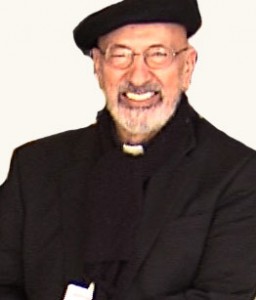 he discusses the image itself that was left for all of us. Â Then he talks about our relationship with her today!
he discusses the image itself that was left for all of us. Â Then he talks about our relationship with her today!
Ps 1:1Rv 11:19a; 12:1-6a, 10ab
and the ark of his covenant could be seen in the temple.A great sign appeared in the sky, a woman clothed with the sun,
with the moon under her feet,
and on her head a crown of twelve stars.
She was with child and wailed aloud in pain as she labored to give birth.
Then another sign appeared in the sky;
it was a huge red dragon, with seven heads and ten horns,
and on its heads were seven diadems.
Its tail swept away a third of the stars in the sky
and hurled them down to the earth.
Then the dragon stood before the woman about to give birth,
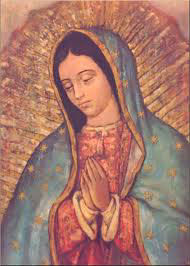
to devour her child when she gave birth.
She gave birth to a son, a male child,
destined to rule all the nations with an iron rod.
Her child was caught up to God and his throne.
The woman herself fled into the desert
where she had a place prepared by God.Then I heard a loud voice in heaven say:
“Now have salvation and power come,
and the Kingdom of our God
and the authority of his Anointed.”
Tags: heaven, John Esseff, our lady of guadalupe, reflection, relationship
This entry was posted on Wednesday, December 12th, 2012 at 5:42 am
You can follow any responses to this entry through the RSS 2.0 feed.
“I am a nobody, I am a small rope, a tiny ladder, the tail end, a leaf.â€Â – Saint Juan Diego
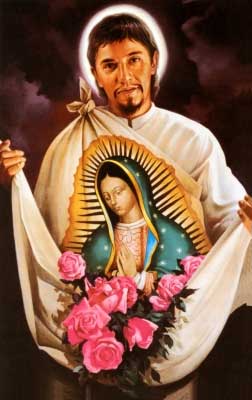
CNA – Born in 1474 in Cuauhtitlán, Mexico, to an Aztec tribe given the name Cuauhtlatoatzin, or “talking eagle.†He belonged to the poorest and most numerous class of the Aztecs, besides that of the slaves. He worked the land and wove mats for a living, and was married although he and his wife had no children.
He converted to Christianity in 1524 and was baptized along with his wife and took the name Juan Diego. He had already been of a mystical character before his baptism, spending long periods of time alone in contemplation.
In 1531, two years after the death of his wife, Maria Lucia, Juan Diego began receiving the famous apparitions of Our Lady of Guadalupe, patron of the Americas, who spoke to him in his native tongue, Nahuatl, and imprinted an image of Herself on his tilma – a poor indian’s cape, and instructed him to have the bishop build a church on the site of the apparition – now the Basilica of Our Lady of Guadalupe, the most visited church in the world, after Saint Peter’s in Rome.
Our Lady of Guadalupe, with Juan Diego’s cooperation, is said to be directly responsible for the 9 million or so conversions to Catholicism by the native Mexican only 20 years after Christianity was introduced to the land by the Spanish.
He died on May 30, 1548 and was canonized by Pope John Paul II in Mexico City on July 31, 2002 – CNA
Tags: apparition, apparitions of our lady, basilica of our lady of guadalupe, bishop, death, juan diego, Maria Lucia, mexico city, saint juan diego
This entry was posted on Sunday, December 9th, 2012 at 1:42 am
You can follow any responses to this entry through the RSS 2.0 feed.
The Immaculate Conception Room, located in the heart of the Vatican Museums, regained its glory in 2007, after an extensive restoration. Now, just years later, the spotlight returns for the publication of an spectacular book about its frescoes.
Tags: frescoes, heart, immaculate conception, vatican, vatican museum, Vatican Museums
This entry was posted on Saturday, December 8th, 2012 at 12:34 am
You can follow any responses to this entry through the RSS 2.0 feed.
“For with God nothing will be impossible”
[powerpress]
an excerpt from today’s reflection by Don Schwager: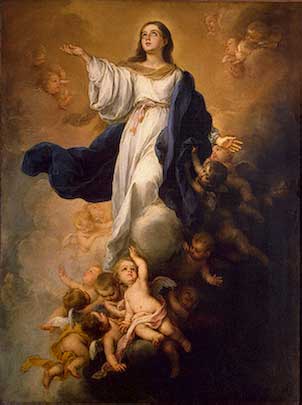
What is the key that can unlock the power and grace of God’s kingdom in our personal lives? Faith and obedience for sure! When Adam and Eve disobeyed God, they immediately experienced the consequence of their action – separation from the God who loved them. God in his mercy promised them a Redeemer who would pay the price for their sin and the sin of the world. We see the marvelous unfolding of God’s plan of redemption in the events leading up to the Incarnation, the birth of the Messiah. Mary’s prompt response of “yes” to the divine message is a model of faith for all believers. Mary believed God’s promises even when they seemed impossible. She was full of grace because she trusted that what God said was true and would be fulfilled. She was willing and eager to do God’s will, even if it seemed difficult or costly. God gives us grace and he expects us to respond with the same willingness, obedience, and heart-felt trust as Mary did. When God commands he also gives the grace, strength, and means to respond. We can either yield to his grace or resist and go our own way. Do you believe in God’s promises and do you yield to his grace?
“Heavenly Father, you offer us abundant grace, mercy, and forgiveness through your Son, Our Lord Jesus Christ. Help me to live a grace-filled life as Mary did by believing in your promises and by giving you my unqualified “yes” to your will and to your plan for my life.”
for the full reflection visit : Daily Reading and Meditation
Tags: blessed virgin mary, blessed virgin mother, don schwager, forgiveness, full of grace, gospel of luke, immaculate conception, mercy, sin, solemnity of the immaculate conception
This entry was posted on Saturday, December 8th, 2012 at 12:02 am
You can follow any responses to this entry through the RSS 2.0 feed.
“Remember always…a tranquil conscience and an assured innocence produce a blessed life”
blessed life”
Saint Ambrose (c. between 337 and 340 – 4 April 397), was a bishop of Milan who became one of the most influential Church figures of the 4th century. Mariologist, heresy buster, emperor tamer, lover of hymns, an answer to a mother’s prayer (ask St. Monica), you name it, St. Ambrose fills the bill…
Did you know that St. Ambrose was one of the first recorded instances of someone reading silently? Interesting…
 Did you know that he received, essentially, the sacramental Grand Slam all at once? Wonder what that is?
Did you know that he received, essentially, the sacramental Grand Slam all at once? Wonder what that is?
…well let’s ask Mike Aquilina. Take a listen [powerpress]
For a fuller a rendering of his life, visit New Advent
So, so much from St. Ambrose! First, better to hear from the man himself (sort of…)
On Holy Mary
Next on Holy Repentance
A prayer of St. Ambrose
Lord Jesus Christ, I approach your banquet table in fear and trembling, for I am a sinner, and dare not rely on my own worth but only on your goodness and mercy. I am defiled by many sins in body and soul, and by my unguarded thoughts and words.
Gracious God of majesty and awe, I seek your protection, I look for your healing. Poor troubled sinner that I am, I appeal to You, the fountain of all mercy. I cannot bear your judgment, but I trust in your salvation. Lord, I show my wounds to You and uncover my shame before You. I know my sins are many and great, and they will fill me with fear, but I hope in Your Mercies, for they cannot be numbered.
Lord Jesus Christ, eternal king, God and man, crucified for mankind, look upon me with mercy and hear my prayer, for I trust in You. Have mercy on me, full of sorrow and sin, for the depth of your compassion never ends.
Praise to You, saving sacrifice, offered on the wood of the cross for me and for all mankind. Praise to the noble and precious blood, flowing from the wounds of my crucified Lord Jesus Christ and washing away the sins of the whole world. Remember, Lord, your creature, whom You have redeemed with Your Blood. I repent my sins, and I long to put right what I have done. Merciful Father, take away all my offenses and sins; purify me in body and soul, and make me worthy to taste the holy of holies.
May Your Body and Blood, which I intend to receive, although I am unworthy, be for me the remission of my sins, the washing away of my guilt, the end of my evil thoughts, and the rebirth of my better instincts. May it incite meto do the works pleasing to You and profitable to my health in body andsoul, and be a firm defense against the wiles of my enemies.
Tags: Church, conscience, doctors of the church, father of the church, fathers mike, mercy, mike aquilina, Saint Ambrose, st ambrose, st. paul center for biblical theology
This entry was posted on Friday, December 7th, 2012 at 12:21 am
You can follow any responses to this entry through the RSS 2.0 feed.
Once again we are joined by the fantastic Dr. Matthew Bunson!  We discuss his new work which brings us the life of  “St. Kateri: Lily of the Mohawks”.  The humble daughter of a Mohawk chief and a Roman Catholic mother, Kateri (named after St. Catherine of Siena) Tekakwitha lived a short life (she died at the age of 24). But she was such a powerful witness, so much so, that even the famed “black robe” Jesuit missionaries were awed  “by her perfection of the virtues, her mystical prayer life, and her total love for Christ.”  Her last words were: “Jesus, I love you.”  No one tells a story like Dr. Bunson, and he doesn’t fail to captivate this time when describing  the life of this remarkably holy woman.
“St. Kateri: Lily of the Mohawks”.  The humble daughter of a Mohawk chief and a Roman Catholic mother, Kateri (named after St. Catherine of Siena) Tekakwitha lived a short life (she died at the age of 24). But she was such a powerful witness, so much so, that even the famed “black robe” Jesuit missionaries were awed  “by her perfection of the virtues, her mystical prayer life, and her total love for Christ.”  Her last words were: “Jesus, I love you.”  No one tells a story like Dr. Bunson, and he doesn’t fail to captivate this time when describing  the life of this remarkably holy woman.
[powerpress]
You can find the book here
“Written by experienced and prolific authors Matthew and Margaret Bunson, St. Kateri: Lily of the Mohawks is the most definitive biography of Kateri Tekakwitha.”
Here is St. Kateri and Dr. Matthew Bunson featured on “Rome Reports”
Tags: osv, our sunday visitor
This entry was posted on Tuesday, November 13th, 2012 at 3:34 pm
You can follow any responses to this entry through the RSS 2.0 feed.
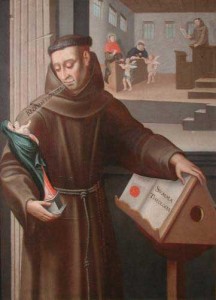 Blessed John Duns Scotus, the teacher of “God’s closeness”. I love the homily below on this great theologian and lover of the Blessed Mother.Â
Blessed John Duns Scotus, the teacher of “God’s closeness”. I love the homily below on this great theologian and lover of the Blessed Mother.Â
CNA- Pope Benedict XVI taught about Franciscan priest and teacher Blessed John Duns Scotus, in one of his Wednesday audiences in July of 2010.  The Holy Father remembered his loyalty and devotion to Christ, the Church and the Successor of St. Peter, as well as his contributions to Christian thought.
During his catechesis, the Pope recalled the life of the medieval Scottish priest and theologian, Blessed John Duns Scotus. He spoke of how the Franciscan, who taught at Oxford, Cambridge, and later in Paris, left France instead of betraying Pope Boniface VIII who was in conflict with King Phillip IV.
This fact, said the Pope, “invites us to remember how many times in the history of the Church, believers have found hostility and promptly even persecution because of their loyalty and devotion to Christ, to the Church and to the Pope.
“We all look with admiration to these Christians, that teach us to protect as a precious inheritance the faith in Christ and the communion with the Successor of Peter and, therefore, with the Universal Church.”
Continuing on the life of the 13th century Franciscan, the Pope said that Blessed Scotus provided three major contributions to Christian thought. The first gift is his “great Christocentric vision” that in the Incarnation “every creature, in and through Christ, is called to be perfected in grace and to glorify God forever.” The second contribution is the theory which led to the dogma “that Our Lady’s preservation from original sin was a privilege granted in view of her Son’s redemptive passion and death.” And finally, Pope Benedict noted his “great attention to the issue of human freedom”as one of his gifts to Christian thought. (more…)
Tags: blessed john duns scotus, blessed mother, Church, death, franciscan priest, homily, love, medieval theologian, pope benedict xvi, theologian
This entry was posted on Thursday, November 8th, 2012 at 4:04 am
You can follow any responses to this entry through the RSS 2.0 feed.
I love this book…what a wonderful introduction on how the Communion of Saints can change our lives.   Colleen Carroll Campbell writes a beautiful memoir that not only chronicles the  important passages of life she’s traveled thus far, but she also shares the guidance and insight she has received from several “sister” saints she has met along the way…St. Teresa of Avila, St. Therese of Lisieux, St. Faustina, St. Teresa Benedicta of the Cross (Edith Stein), Bl. Teresa of Calcutta and, of course, the Queen and Mother of them all, The Blessed Virgin Mary.  This work is more than just a cataloging of the events of her life or facts about these incredible women, Colleen shares a compelling story that is truly a page turner.  It was a book that brought  great joy and peace to my heart; it helped me  to reflect on, and appreciate more fully, those wonderful members of the “Cloud of Witnesses” who have touched my life….what a true gift God has given us in the Communion of the Saints.  A  HIGHLY recommended book on all levels.
Colleen Carroll Campbell writes a beautiful memoir that not only chronicles the  important passages of life she’s traveled thus far, but she also shares the guidance and insight she has received from several “sister” saints she has met along the way…St. Teresa of Avila, St. Therese of Lisieux, St. Faustina, St. Teresa Benedicta of the Cross (Edith Stein), Bl. Teresa of Calcutta and, of course, the Queen and Mother of them all, The Blessed Virgin Mary.  This work is more than just a cataloging of the events of her life or facts about these incredible women, Colleen shares a compelling story that is truly a page turner.  It was a book that brought  great joy and peace to my heart; it helped me  to reflect on, and appreciate more fully, those wonderful members of the “Cloud of Witnesses” who have touched my life….what a true gift God has given us in the Communion of the Saints.  A  HIGHLY recommended book on all levels.
[powerpress]
 You can find the book here
You can find the book here
“Colleen Carroll Campbell has encountered most of the challenges confronting young women today—balancing dating, courtship, and marriage with a successful career, caring for a parent with Alzheimer’s, dealing with infertility—but she hasn’t faced these challenges alone. In My Sisters the Saints, Campbell introduces us to the women who helped her along the way – women like Teresa of Avila, Therese of Lisieux, Edith Stein, and, of course, the Blessed Virgin Mary. Completely contemporary and totally timeless, My Sisters the Saints is an engaging spiritual memoir and the perfect guidebook for anyone who is looking for a companion to help her navigate life’s sometimes difficult and confusing journey.†– Cardinal Timothy Dolan, Archbishop of New York
“In this fascinating memoir, Colleen Carroll Campbell recounts her discovery of kinship with six great women saints at crucial junctures on her journey through life. My Sisters the Saints is the story of how a thoroughly modern woman drew inspiration and strength from her spiritual ‘sisters’ while struggling with the mysteries of life, love, illness, and death in today’s world. This lovely and highly readable book will touch many lives.â€â€¨- Mary Ann Glendon, former U.S. Ambassador to the Vatican, Harvard Law professor, and President of the Pontifical Academy of Social Sciences
Tags: Cardinal Timothy Dolan, Colleen Carroll Campbell, image books, Mary Ann Glendon, women
This entry was posted on Monday, November 5th, 2012 at 1:58 pm
You can follow any responses to this entry through the RSS 2.0 feed.
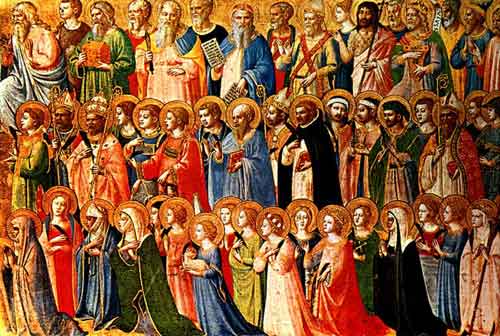 OOOOOOOh Yea ….!!!
OOOOOOOh Yea ….!!!
Tags: saints
This entry was posted on Thursday, November 1st, 2012 at 12:09 am
You can follow any responses to this entry through the RSS 2.0 feed.
Tags: all saints, litany of saints, prayer
This entry was posted on Thursday, November 1st, 2012 at 12:08 am
You can follow any responses to this entry through the RSS 2.0 feed.
TERESA OF AVILA: CONTEMPLATIVE AND INDUSTRIOUS
VATICAN CITY, 2 FEB 2011 (vatican.va) –
Dear Brothers and Sisters,
In the course of the Catecheses that I have chosen to dedicate to the Fathers of the Church and to great theologians and women of the Middle Ages I have also had the opportunity to reflect on certain Saints proclaimed Doctors of the Church on account of the eminence of their teaching.
Today I would like to begin a brief series of meetings to complete the presentation on the Doctors of the Church and I am beginning with a Saint who is one of the peaks of Christian spirituality of all time — St Teresa of Avila [also known as St Teresa of Jesus].
St Teresa, whose name was Teresa de Cepeda y Ahumada, was born in Avila, Spain, in 1515. In her autobiography she mentions some details of her childhood: she was born into a large family, her “father and mother, who were devout and feared Godâ€, into a large family. She had three sisters and nine brothers.
While she was still a child and not yet nine years old she had the opportunity to read the lives of several Martyrs which inspired in her such a longing for martyrdom that she briefly ran away from home in order to die a Martyr’s death and to go to Heaven (cf. Vida, [Life], 1, 4); “I want to see Godâ€, the little girl told her parents.
A few years later Teresa was to speak of her childhood reading and to state that she had discovered in it the way of truth which she sums up in two fundamental principles.
On the one hand was the fact that “all things of this world will pass away†while on the other God alone is “for ever, ever, everâ€, a topic that recurs in her best known poem: “Let nothing disturb you, Let nothing frighten you, All things are passing away: God never changes. Patience obtains all things. Whoever has God lacks nothing; God alone sufficesâ€. She was about 12 years old when her mother died and she implored the Virgin Most Holy to be her mother (cf. Vida, I, 7).
If in her adolescence the reading of profane books had led to the distractions of a worldly life, her experience as a pupil of the Augustinian nuns of Santa MarÃa de las Gracias de Avila and her reading of spiritual books, especially the classics of Franciscan spirituality, introduced her to recollection and prayer.
When she was 20 she entered the Carmelite Monastery of the Incarnation, also in Avila. In her religious life she took the name “Teresa of Jesusâ€. Three years later she fell seriously ill, so ill that she remained in a coma for four days, looking as if she were dead (cf. Vida, 5, 9).
In the fight against her own illnesses too the Saint saw the combat against weaknesses and the resistance to God’s call: “I wished to liveâ€, she wrote, “but I saw clearly that I was not living, but rather wrestling with the shadow of death; there was no one to give me life, and I was not able to take it. He who could have given it to me had good reasons for not coming to my aid, seeing that he had brought me back to himself so many times, and I as often had left him†(Vida, 7, 8).
In 1543 she lost the closeness of her relatives; her father died and all her siblings, one after another, emigrated to America. In Lent 1554, when she was 39 years old, Teresa reached the climax of her struggle against her own weaknesses. The fortuitous discovery of the statue of “a Christ most grievously woundedâ€, left a deep mark on her life (cf. Vida, 9).
The Saint, who in that period felt deeply in tune with the St Augustine of the Confessions, thus describes the decisive day of her mystical experience: “and… a feeling of the presence of God would come over me unexpectedly, so that I could in no wise doubt either that he was within me, or that I was wholly absorbed in him†(Vida, 10, 1).
Parallel to her inner development, the Saint began in practice to realize her ideal of the reform of the Carmelite Order: in 1562 she founded the first reformed Carmel in Avila, with the support of the city’s Bishop, Don Alvaro de Mendoza, and shortly afterwards also received the approval of John Baptist Rossi, the Order’s Superior General.
In the years that followed, she continued her foundations of new Carmelite convents, 17 in all. Her meeting with St John of the Cross was fundamental. With him, in 1568, she set up the first convent of Discalced Carmelites in Duruelo, not far from Avila.
In 1580 she obtained from Rome the authorization for her reformed Carmels as a separate, autonomous Province. This was the starting point for the Discalced Carmelite Order.
Indeed, Teresa’s earthly life ended while she was in the middle of her founding activities. She died on the night of 15 October 1582 in Alba de Tormes, after setting up the Carmelite Convent in Burgos, while on her way back to Avila. Her last humble words were: “After all I die as a child of the Churchâ€, and “O my Lord and my Spouse, the hour that I have longed for has come. It is time to meet one anotherâ€.
Teresa spent her entire life for the whole Church although she spent it in Spain. She was beatified by Pope Paul V in 1614 and canonized by Gregory XV in 1622. The Servant of God Paul VI proclaimed her a “Doctor of the Church†in 1970.
Teresa of Jesus had no academic education but always set great store by the teachings of theologians, men of letters and spiritual teachers. As a writer, she always adhered to what she had lived personally through or had seen in the experience of others (cf. Prologue to The Way of Perfection), in other words basing herself on her own first-hand knowledge.
Teresa had the opportunity to build up relations of spiritual friendship with many Saints and with St John of the Cross in particular. At the same time she nourished herself by reading the Fathers of the Church, St Jerome, St Gregory the Great and St Augustine.
Among her most important works we should mention first of all her autobiography, El libro de la vida (the book of life), which she called Libro de las misericordias del Señor [book of the Lord’s mercies].
Written in the Carmelite Convent at Avila in 1565, she describes the biographical and spiritual journey, as she herself says, to submit her soul to the discernment of the “Master of things spiritualâ€, St John of Avila. Her purpose was to highlight the presence and action of the merciful God in her life. For this reason the work often cites her dialogue in prayer with the Lord. It makes fascinating reading because not only does the Saint recount that she is reliving the profound experience of her relationship with God but also demonstrates it.
In 1566, Teresa wrote El Camino de Perfección [The Way of Perfection]. She called itAdvertencias y consejos que da Teresa de Jesús a sus hermanas [recommendations and advice that Teresa of Jesus offers to her sisters]. It was composed for the 12 novices of the Carmel of St Joseph in Avila. Teresa proposes to them an intense programme of contemplative life at the service of the Church, at the root of which are the evangelical virtues and prayer.
Among the most precious passages is her commentary on the Our Father, as a model for prayer. St Teresa’s most famous mystical work is El Castillo interior [The Interior Castle]. She wrote it in 1577 when she was in her prime. It is a reinterpretation of her own spiritual journey and, at the same time, a codification of the possible development of Christian life towards its fullness, holiness, under the action of the Holy Spirit.
Teresa refers to the structure of a castle with seven rooms as an image of human interiority. She simultaneously introduces the symbol of the silk worm reborn as a butterfly, in order to express the passage from the natural to the supernatural.
The Saint draws inspiration from Sacred Scripture, particularly the Song of Songs, for the final symbol of the “Bride and Bridegroom†which enables her to describe, in the seventh room, the four crowning aspects of Christian life: the Trinitarian, the Christological, the anthropological and the ecclesial.
St Teresa devoted the Libro de la fundaciones [book of the foundations], which she wrote between 1573 and 1582, to her activity as Foundress of the reformed Carmels. In this book she speaks of the life of the nascent religious group. This account, like her autobiography, was written above all in order to give prominence to God’s action in the work of founding new monasteries.
It is far from easy to sum up in a few words Teresa’s profound and articulate spirituality. I would like to mention a few essential points. In the first place St Teresa proposes the evangelical virtues as the basis of all Christian and human life and in particular, detachment from possessions, that is, evangelical poverty, and this concerns all of us; love for one another as an essential element of community and social life; humility as love for the truth; determination as a fruit of Christian daring; theological hope, which she describes as the thirst for living water. Then we should not forget the human virtues: affability, truthfulness, modesty, courtesy, cheerfulness, culture.
Secondly, St Teresa proposes a profound harmony with the great biblical figures and eager listening to the word of God. She feels above all closely in tune with the Bride in the Song of Songs and with the Apostle Paul, as well as with Christ in the Passion and with Jesus in the Eucharist. The Saint then stresses how essential prayer is. Praying, she says, “means being on terms of friendship with God frequently conversing in secret with him who, we know, loves us†(Vida 8, 5). St Teresa’s idea coincides with Thomas Aquinas’ definition of theological charity as “amicitia quaedam hominis ad Deumâ€, a type of human friendship with God, who offered humanity his friendship first; it is from God that the initiative comes (cf. Summa Theologiae II-II, 23, 1).
Prayer is life and develops gradually, in pace with the growth of Christian life: it begins with vocal prayer, passes through interiorization by means of meditation and recollection, until it attains the union of love with Christ and with the Holy Trinity. Obviously, in the development of prayer climbing to the highest steps does not mean abandoning the previous type of prayer. Rather, it is a gradual deepening of the relationship with God that envelops the whole of life.
Rather than a pedagogy Teresa’s is a true “mystagogy†of prayer: she teaches those who read her works how to pray by praying with them. Indeed, she often interrupts her account or exposition with a prayerful outburst.
Another subject dear to the Saint is the centrality of Christ’s humanity. For Teresa, in fact, Christian life is the personal relationship with Jesus that culminates in union with him through grace, love and imitation. Hence the importance she attaches to meditation on the Passion and on the Eucharist as the presence of Christ in the Church for the life of every believer, and as the heart of the Liturgy. St Teresa lives out unconditional love for the Church: she shows a lively “sensus Ecclesiaeâ€, in the face of the episodes of division and conflict in the Church of her time.
She reformed the Carmelite Order with the intention of serving and defending the “Holy Roman Catholic Churchâ€, and was willing to give her life for the Church (cf. Vida, 33,5).
A final essential aspect of Teresian doctrine which I would like to emphasize
is perfection, as the aspiration of the whole of Christian life and as its ultimate goal. The Saint has a very clear idea of the “fullness†of Christ, relived by the Christian. At the end of the route through The Interior Castle, in the last “roomâ€, Teresa describes this fullness, achieved in the indwelling of the Trinity, in union with Christ through the mystery of his humanity.
Dear brothers and sisters, St Teresa of Jesus is a true teacher of Christian life for the faithful of every time. In our society, which all too often lacks spiritual values, St Teresa teaches us to be unflagging witnesses of God, of his presence and of his action. She teaches us truly to feel this thirst for God that exists in the depths of our hearts, this desire to see God, to seek God, to be in conversation with him and to be his friends.
This is the friendship we all need that we must seek anew, day after day. May the example of this Saint, profoundly contemplative and effectively active, spur us too every day to dedicate the right time to prayer, to this openness to God, to this journey, in order to seek God, to see him, to discover his friendship and so to find true life; indeed many of us should truly say: “I am not alive, I am not truly alive because I do not live the essence of my lifeâ€.
Therefore time devoted to prayer is not time wasted, it is time in which the path of life unfolds, the path unfolds to learning from God an ardent love for him, for his Church, and practical charity for our brothers and sisters. Many thanks.
Check out Teresa of Avila’s Discerning Hearts Page
Tags: st teresa, st teresa of jesus, Teresa of Avila, Teresa of Jesus
This entry was posted on Monday, October 15th, 2012 at 12:11 am
You can follow any responses to this entry through the RSS 2.0 feed.
The Novena to St. Teresa of Avila, Day 9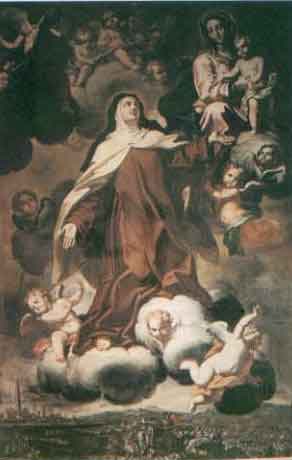
composed by  by St. Alphonsus of Liguori
Join in on Day 9 [powerpress = “devotionals-prayers”]
Teresa, making her sweetly to die of love; we pray Thee, by Thy merits, and by those of Thy most affectionate spouse, to grant us a good death; and if we do not die of love, yet, that we may at least die burning of love for Thee, that so dying, we may be able to go and love Thee for evermore with a more perfect love in heaven.
Say one Our Father, Hail Mary and Glory be.
V. St. Teresa, pray for us:
R. That we may become worthy of the promises of Jesus Christ.
Let us pray: Graciously hear us, O God of our salvation! that as we rejoice in the commemoration of the blessed virgin Teresa, so we may be nourished by her heavenly doctrine, and draw from thence the fervour of a tender devotion; through our Lord Jesus Christ, Thy Son, Who liveth and reigneth with Thee in the unity of the Holy Spirit, God for ever and ever. Amen.
This entry was posted on Sunday, October 14th, 2012 at 12:08 am
You can follow any responses to this entry through the RSS 2.0 feed.


